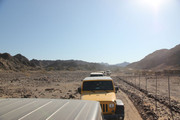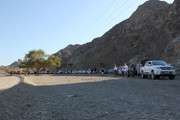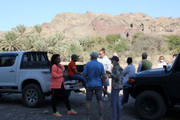Rock & Sand 02/01/2021
- NahorJP
- Intermediate

- Posts: 54
- Joined: Sun Mar 08, 2020 1:46 pm
- Location: Dubai
- Has thanked: 32 times
- Been thanked: 36 times
Very informative report!osman wrote: Wed Jan 06, 2021 3:46 pm Dear Almosters,
I like to start with a thanks to @alshamsi_m for allowing me to join the drive from the wait list of the wait list. I am so glad I joined this scenic drive so did my wife.
As everybody mentioned above, it was a relaxed drive with no pop out, no recovery and not even a single second try. It is a family drive, meeting of two families: first and second one...
So, lets write something different for a change and see if we can remember what we saw. But we have to trust uncle google for the information I compiled:
Starting with Ghaf Tree, scientifically called as Prosopis cineraria. This tree needs few more words of fact since it is the national tree of UAE:
- The Ghaf Tree is able to tap water from 30 m below the ground. Its presence points to the availability of underground water in the desert. So, it is a ‘phreatophyte’ or a plant whose rooting system is in contact with the water table.
- A lone Ghaf Tree in the desert serves as a niche ecosystem by itself. It supports mammals, reptiles, scorpions, rodents, insects and birds. It also enriches the soil and helps fix nitrogen in the air.
- The seeds can germinate only when there is heavy rain. Even then, the seed pods get eaten by animals as they are easily digestible. Hence the tree also propagates itself through asexual reproduction from its lateral roots. You may find an offspring of a Ghaf Tree at a great distance from the parent tree.
- Its fruits, flowers and leaves are an important source of food for animals in the desert as they are rich in proteins.
- The Ghaf can withstand very high temperatures and very dry conditions. The leaves are small to help reduce any loss of water due to evaporation.
- In the past, the nomads used its leaves in salads. Its wood was traditionally used for construction and as fuel.
I find Samur (or Umbrella Thorn Acacia), scientifically called as Acacia tortilis very aesthetic. There is a plain only a few kilometres before our meeting point where you can see hundreds of them. Every time I travel to Dibba, that scenery mesmerises me. Samur has the following interesting facts:
- The Acacia tortilis is a typical tree which grows in hard soil near mountain areas or hard gravel plains unlike the Ghaf which is found in the desert or sandy areas.
- As the Acacia groves inhabit gravel plains or mountain areas, the roots are unable to penetrate deep under the soil like the Ghaf. Acacia trees in the wadis depend on runoff water coming down the mountains after the rains or from flash floods.
- The tree is also shaped like an umbrella so as to absorb moisture from the air through dew to meet its water requirements. The Acacia tortilis has a highly aromatic white flower. It can withstand high temperatures and poor soil.
- The tree provides shade in the desert and the leaves are eaten by goats and camels.
- The gum of the Acacia is edible and parts of the tree, including roots, shoots and pods, which are twisted and spiral shaped (hence the name “tortilis”), were used for decoration, weapons and medicines.
- Extracting honey from the Samur trees, the main source of honey in the UAE, is an age old tradition. The honey produced has a distinct flavour.
- It has excellent medicinal properties – helps with digestive disorders, diarrhea and also helps check bleeding.
We have another Samur tree which is scientifically called as Acacia ehrenbergiana. Although it has the same arabic name as the one above, they look very diferent. Both are from the same family but only different species.
Our first stop for a break is in a valley with lots of trees, and hence the name of the valley is. The source of the tasty dark honey is from the Sidr trees, which they are scientifically called as Ziziphus spina-christi.
After we cleared out from the valleys and rocky environment, we started to drive on the sand and started to see lots of Desert Squash, which they looked like miniature versions of water melon or melon. It was very tempting to grab one and eat but it says Citrullus colocynthis are extremely bitter in taste.
Post report comment: I tried to put html links to the red items above as embedded URL but the portal does not allow more than one link. For each plant there is one form Dubai Desert Conservation Reserve and one from Wikipedia. Below are the open links and you can search if you further interested.
Ghaf Tree:
https://www.ddcr.org/florafauna/Detail. ... ree&Id=238
https://en.wikipedia.org/wiki/Prosopis_cineraria
Samur Tree (1):
https://www.ddcr.org/FloraFauna/Detail. ... ees&Id=239
https://en.wikipedia.org/wiki/Vachellia_tortilis
Samur Tree (2):
https://www.ddcr.org/florafauna/Detail. ... ees&Id=240
https://en.wikipedia.org/wiki/Vachellia_flava
Sidr Tree:
https://www.ddcr.org/florafauna/Detail. ... ees&Id=243
https://en.wikipedia.org/wiki/Ziziphus_spina-christi
Desert Squash:
https://www.ddcr.org/florafauna/Detail. ... rbs&Id=203
https://en.wikipedia.org/wiki/Citrullus_colocynthis
Finishing the report, here are a few pictures from the drive.

Thanks
Roan (Night Fury)
See you on Sands!! Sooner the Better!!
Roan (Night Fury)
See you on Sands!! Sooner the Better!!







